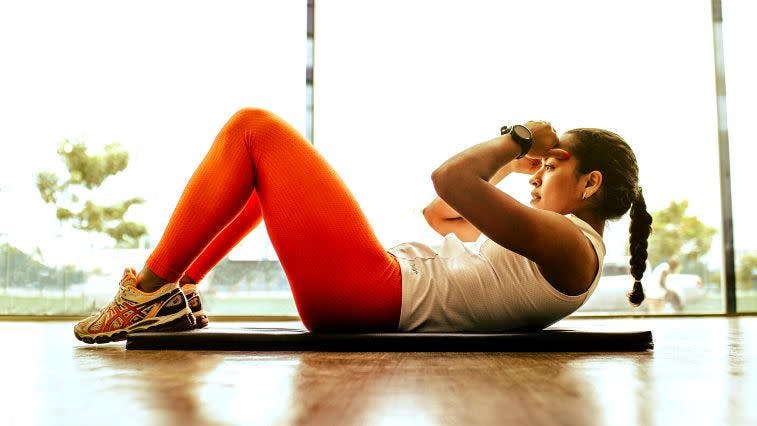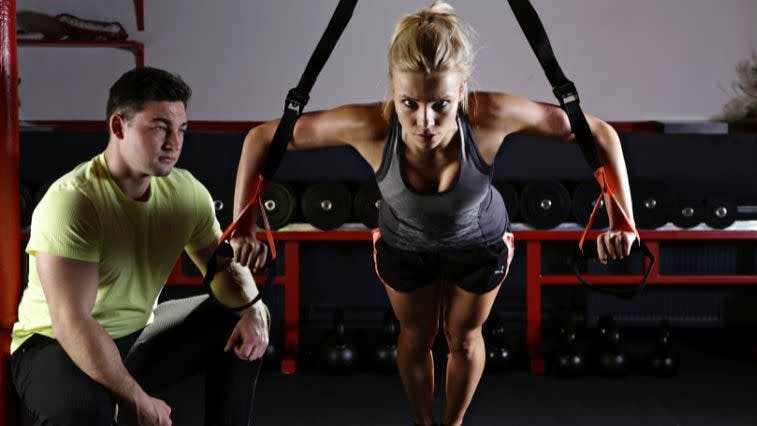Avoid These Common Beginner Workout Routine Mistakes Before You Get Started
Our content strives to support, inform, and motivate you to meet your health goals. We want to be your trusted source of expert- and science-backed info dispensed in simple, actionable ways. Read our Editorial Guidelines.
The number of beginner workout routines available is practically endless — in addition to routines provided in person by trainers and gyms, there are millions of options available online and in apps through credible (and less credible) resources. Whether you want to run your first 5k, lose body fat, develop a bigger butt, tackle a triathlon, or just improve your overall health, finding a workout routine isn’t hard… but finding the right routine for you takes more thought and planning.
Many beginners — those who are brand new to working out and even those who used to exercise but have taken a lot of time off — get swept up in “let’s-do-this” motivation and can fall into the trap of doing any workout routine they find online without any idea of how to pair one type of workout with another, how much rest to take in between, and even whether the workouts and sequence of workouts will help them achieve their goals.
So, what makes a good beginner workout routine? That answer is incredibly personal and nuanced. Just because a routine may be well-designed, progressive, and geared to a particular fitness level doesn’t mean it’s a good workout routine for you.
This isn’t meant to frustrate you or hold you back when you’re raring to go, but it’s a reminder that you don’t want to put in a bunch of effort and not see results. We’ll help you avoid the most common beginner workout routine mistakes by prompting you to think about what type of routine you need, and how it will fit into your schedule and life.
After all, the best workout routine out there isn’t necessarily the one that’s making headlines. It’s the one that’ll help you meet your goals but — more importantly — that you’ll stick with and enjoy.
Choose a Workout Routine That’s Right for You Right Now
Because no two people are alike, no two workout routines should be exactly alike. Even if you and your best friend have the exact same fitness goals, you likely don’t have the same work schedule, access to gyms, budget for equipment or training, or family structure and needs, all of which can impact the design of a reasonable and maintainable workout routine.
To be able to choose and stick to a workout routine, think about your:
current fitness level
long- and short-term goals
resources
available time
how you’ll respond to common barriers like illness or changes in schedules
If you choose to work with a personal trainer, they can help you think through some of these things, but at a minimum, you should ask yourself the following questions and answer them honestly.
Am I new to working out or do I have some previous experience?
Even if you used to play sports or you once spent all your evenings at the gym, if you haven’t been active in a while, it’s best to assume you’ll need to start at a beginner or intermediate level. You likely won’t have the stamina or strength you once had, and this can affect your form. It’s always better to start with a beginner’s routine and advance as you feel ready, rather than start too advanced and end up with an injury or are too sore to move.
What will my schedule allow?
Sure, you may want to exercise five days a week, but will your schedule allow for it? Sit down with your calendar and think about your current routine — can you reasonably fit in five 60-minute workouts a week, or is it more reasonable to schedule three 30-minute workouts per week and do them successfully before trying to add more time? Also, don’t ignore the time you need to drive to the gym (if you plan on going to a gym) and shower after your workouts. If that 60-minute workout turns into a two-hour time commitment due to these extraneous tasks, are you really going to be able to do it consistently? Be honest about where you’re starting and actually block out the days and times you plan to exercise (plus commute and get ready) on your calendar.
What are my fitness goals?

Very generally speaking, fitness goals often have to do with losing weight, gaining muscle, or training for a specific event. Knowing your overarching goal is important, as it can help you select the type of workout routine you should follow, but your goals shouldn’t stop there. For example, if you want to gain muscle, ask yourself:
What’s the end result I’m shooting for?
Is it possible for me to achieve this particular physique? (Your genetics and gender could impact this)
How will you make your workouts progressive so you continue gaining strength? Will you lift heavier weights (and do you have the budget to buy them if you work out at home), lift with more intensity, or increase your reps and sets?
Each fitness goal will require a different training approach, even if it’s only slightly different.
You should also think about how to make your goals SMART (specific, measurable, attainable, realistic, and time-constrained). If your goal is to lose weight, ask yourself:
How much weight do you want to lose?
What date or month would you like to achieve your weight loss goal?
Is your time and weight loss goal attainable — are you giving yourself enough time to meet the goal?
Is the goal weight realistic based on your height and body structure?
How and when will you track your progress?
The answers to all of these questions can help you find a workout routine that fits your schedule and needs.
Where will I work out?
This is an important consideration that also impacts your budget and time constraints. If you want to work out at home, you need to make sure your home is outfitted to help you meet your goals. Do you have the required space? Do you have equipment? Do you know how to use the equipment? Is the equipment you have appropriate for helping you reach your specific goals, or will you have to purchase more or different equipment? Will you be able to ignore other distractions while working out at home, like family interruptions or the lure of the couch?
On the other hand, if you plan on working out at a gym, what gym will you use? How far is it from home? How long will it take to commute there and back? What will it cost? How will you stay motivated to keep going?
What will I do when my plans backfire?
There’s one surefire truth that accompanies every workout routine: It won’t always go as planned. Even if you stick to your routine well for the first month, all it takes is one bad workout, a minor injury, illness, or unexpected family emergency to throw things off track. It’s important to recognize this is normal, okay, and even expected.
But it’s also important to have a plan. In other words, if you can’t go to the gym because you’re at home sick, how can you reframe your workouts to get back on track (even if it means easing your way in slowly) once you’re feeling a little better? If you’re unable to get to the gym one day, how can you fit in some movement or rearrange your workout schedule so you don’t feel like the one lost day is going to throw you off track? Having a plan makes these barriers easier to manage.
How can I track my progress and reward myself along the way?
Lots of people start new workout routines with big goals, but because progress occurs slowly and isn’t always obvious to the naked eye, a few weeks or months in they may feel their motivation dipping.
For this reason, it’s important to schedule weekly and monthly “check-ins” to track progress, congratulate, and reward yourself for the progress (however big or small) you’re making. This can be as simple as acknowledging that this week you lifted five pounds more on the bench press than you did the previous week, or eked out one more push-up than you did your previous workout.
Likewise, if your goal is weight-related, but the scale isn’t budging, start taking body measurements or paying attention to how your jeans fit to see if there are body composition changes taking place that may not be reflected on the scale. Write these “little wins” down and do something to congratulate yourself for a job well done — buy yourself a new book, subscribe to that meditation app you’ve been eyeing, or treat yourself to a post-workout massage.
Once you have a good grasp on where you’re starting from, what your goals are, and how you plan to “attack” your workout routine with commitment, you’ll be in a better position to choose the right workout routine for you.
Modifications to a Workout Routine Are Key for Beginners

As you seek out workout routines aligned with your needs and goals, it’s important to realize that any general workout routine you find online is unlikely to be perfectly suited to you. In other words, you may need to adjust the routine slightly to meet your fitness level, time constraints, or equipment available.
For example, if you’re working out at home and a workout calls for kettlebells, you may have to switch those out for dumbbells if you don’t have kettlebells. You’ll likely have to modify your grip on the dumbbells and maybe even use one heavy dumbbell or two dumbbells to equal the weight in one kettlebell.
Likewise, if a training run calls for a four-mile tempo run one day, but you only have 20 minutes to spare, you may have to switch runs, or simply do a 20-minute tempo run that day. Or, if you find that lunges are uncomfortable for your knees, but a workout always calls for lunges, you may have to switch them out for an alternative, like weighted step-ups, or a bodyweight lunge.
These changes are okay and important because a workout should work for you, not the other way around. Remember: There should be no shame in modifying any workout routine to suit your needs. What’s important is that you’re moving and putting in the work to get stronger.
As you keep exercising, test whether you can perform an exercise you weren’t able to in the beginning. Maybe you’ve built up enough strength and stability to perform those lunges now with light weights. Or maybe you’re ready to try a couple of push-ups from a plank position on your toes before you need to drop down to your knees to finish the set. The point of working out is to build your fitness, and that will require pushing outside of your comfort zone at times. Try it out when you’re ready.